Contxto – Just a few weeks ago, I bought my very first Alexa Echo Dot. I’ve never felt so understood in my whole life. She really gets me.
Voice User Interface (VUI) brought us together. In effect, it enables verbal human to robot communication. I must say that it’s certainly changing the way people interact with technology. In a fast-paced world like our own, that’s extremely valuable.

What’s behind this technology?
Alexa Echo Dot’s voice command device (VCD) is one of the many applications for speech recognition technology. Nowadays, these VCD home appliances can read news stories or tell dad jokes even better than most dads.
This has brought up the concern about potential invasions of privacy, though. Actually, many home appliances essentially are as smart as toddlers. I’m not saying that children are dumb here, but rather VCD is quite advanced.
From automobiles to washing machines to smart TVs, speech recognition is a fast-growing trend that has definitely undergone some improvements over the years.
While former VCDs required users to press DTMF buttons to use the interface, newer devices can register speaking requests without any physical interactions via voice-activated keywords.
Surprisingly, most VCDs can even recognize different accents or dialects. They can also respond or sound more natural or human-like, depending on the settings of course.
Amazon, Microsoft, Google and Apple are the frontrunners in this global tech trend. Pretty much all of the VUI activity in Latin America has been introduced by one of these big names. Despite these tech giants’ global influence, a few Latin American contenders are trying to launch this technology before more foreign companies do.
State of the market in Latin America
Telecentro, Argentina’s main telecommunication services provider, became the first in Latin America to roll out voice control solutions. Powered by Nuance Communications’ Dragon TV platform, it allows instant access to an array of content at the palm of their hand, or should I say the sound of their voice?
“It’s no secret that voice-powered interfaces have become very popular in the home,” said Alberto Pierri, CEO of Telecentro. His company provides gigabit Internet services and OTT video content like Netflix and YouTube.
With this, Dragon TV users can seamlessly interact with monitors simply by making statements to the machine, whether it be “turn on Friends” or “play some MTV” – do people even watch MTV anymore?
Anyways, the ability to make these commands has made sticky remote controls lost in the couch cushions obsolete with the sound of your own voice, soft on the ears or otherwise. Think of it like your TV is a quick-witted man-made machine.
This, along with other initiatives, is what’s making tech investors so “bullish” to see. Just in 2018 alone, 9 out of 10 Latin American companies were already considering implementing a DX (Digital Experience) strategy. Estimates also project that 50 percent of mobile apps will apply speech as their primary user interface by 2021.

Google for Startups’ office in Brazil is even now investing in voice-powered startups more than ever before. Launching a program back in January, they have really invested in the Brazilian startup ecosystem. This will serve as a model for other developing nations to replicate.
The future is audio.
Now, think about the potential use for this technology in Latin America where almost 35 million people (around 10 percent of the population) can’t read or write. Voice technology will certainly narrow this gap and let more people access the digital world.
For this reason, the speech recognition technology market in Latam, worth around US$7 million in 2015, is expected to increase 46-fold to US$346 million by 2024. It will also transform e-Commerce as we know it. Currently, 20 percent of online sales in Latin America are already made through voice commands.
Voice notes over Whatsapp, learning via podcasts and searching through voice assistants are other prominent uses of sound-activated technology. Nowadays, people in Buenos Aires even communicate mostly through audio clips and voice notes.
Not too long ago, these actions required strong Wifi connections or big storage capacities that weren’t exactly efficient enough to use. Today, children born nowadays live with these features every single day.
Imagine that. They were born talking and listening through machines.
This will undoubtedly alter the way humanity interacts with machines. But even more importantly, within ourselves.
-VC







